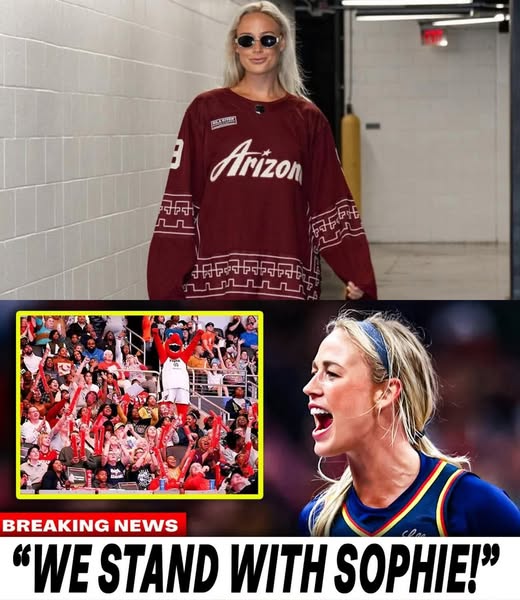
One foul sparked Sophie Cunningham’s fearless stand, exposing a league-wide scandal, selling out jerseys, rallying fans, and igniting a nationwide debate—though not everyone’s cheering. It all started with a single, seemingly routine moment on the basketball court. But what unfolded was anything but ordinary. Sophie Cunningham, a respected player known for her grit and determination, found herself at the center of a controversy that would shake the foundations of the league and spark an intense conversation about fairness, enforcement, and respect in women’s basketball.
The incident happened during a tightly contested game where every play mattered. Cunningham, fiercely defending her teammate Caitlin Clark, committed a foul that was immediately called by the officials. At first glance, it was just another foul, part of the game’s ebb and flow. But Cunningham’s response—calm, yet pointed—transcended the moment. She didn’t just accept the call; she challenged the broader implications of how fouls were being assessed, particularly when it came to star players and high-profile athletes. What followed was a bold and public outcry that resonated far beyond the arena.
Fans quickly caught on. Social media erupted with discussions about the fairness of officiating in women’s basketball. Many echoed Cunningham’s concerns, suggesting that there was a pattern of inconsistent calls that favored certain players while penalizing others harshly. This perceived imbalance sparked outrage and debate across platforms, from Twitter to sports forums and talk shows. It became clear that Cunningham’s foul was a tipping point, a catalyst that revealed a deeper, systemic issue within the league.
As the conversation grew, so did Cunningham’s profile. Her jersey, emblazoned with her name and number, flew off the shelves faster than anyone anticipated. Supporters bought it not just as a symbol of their fandom, but as a badge of solidarity with Cunningham’s stand for justice and equality on the court. The surge in jersey sales was a visible sign of how much her message had struck a chord with fans nationwide. People were rallying behind her not only as an athlete but as a figure of integrity and courage.
At the same time, endorsement deals began to pour in. Brands eager to associate with Cunningham’s image of strength and authenticity stepped forward with lucrative offers. For many companies, aligning with a player who had sparked such a significant movement was an opportunity to connect with passionate, engaged audiences. Cunningham’s marketability soared, proving that standing up for what’s right can translate into real-world success off the court.
However, this wave of support wasn’t universal. Not everyone in the league or its fanbase was cheering. Some critics dismissed Cunningham’s actions as overblown or disruptive. There were those who argued that fouls are an inevitable part of basketball and that Cunningham’s response was an unnecessary escalation. Others worried that the ensuing media frenzy was distracting from the sport itself. Within the league’s administration and officiating community, there was defensiveness and a reluctance to acknowledge any wrongdoing or bias.
The divide highlighted a broader tension within professional sports: the balance between maintaining order and respecting players’ voices. Cunningham’s case underscored the challenges leagues face in addressing calls for reform while preserving the integrity of the game. It also brought to light issues of gender equity, as many observers noted that women’s basketball has often struggled for equal recognition and respect compared to its male counterpart.
Analysts began to dissect the fouling patterns across the league, reviewing footage and statistics to assess whether Cunningham’s claims held merit. The data painted a complex picture—there were inconsistencies, but pinning down intent or bias was difficult. What was undeniable, though, was the passionate response from fans and players alike. Cunningham had tapped into a collective frustration that many had felt but not voiced so publicly.
The incident also opened up conversations about the role of officiating in sports. How should referees be trained? What mechanisms exist for accountability? Could technology, like instant replay or AI-assisted calls, play a bigger role? These questions gained prominence, with Cunningham’s foul serving as a case study in the need for ongoing evaluation and improvement of officiating standards.
Beyond the technical aspects, Cunningham’s stand became a symbol of empowerment. Younger players looked up to her as a role model who wasn’t afraid to speak out. Coaches emphasized the importance of standing up for fairness and integrity. The media spotlight shifted from just athletic performance to the values and character of players, broadening the narrative around women’s sports.
As the league responded, some changes were proposed. Initiatives to improve referee training, increase transparency around calls, and create channels for player feedback were put forward. While progress was gradual and met with some resistance, the conversation sparked by Cunningham’s foul laid the groundwork for future reforms.
In the end, what began as a single foul became a defining moment for Sophie Cunningham and women’s basketball. It exposed a league-wide problem, rallied a passionate fanbase, and challenged the status quo. Though not everyone embraced the change, Cunningham’s fearless stand left an indelible mark, proving that sometimes one moment on the court can spark a movement that reaches far beyond the game itself.




